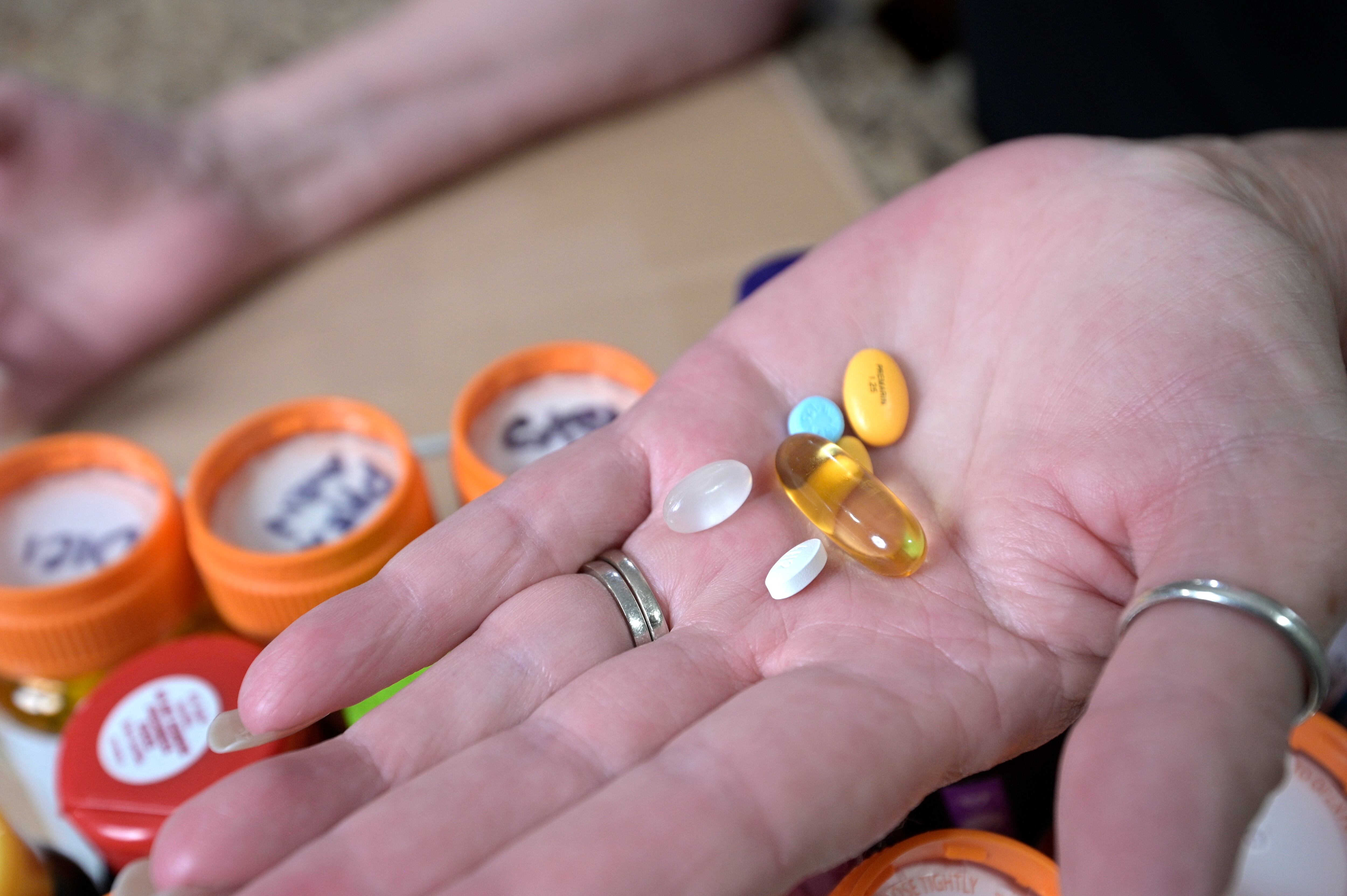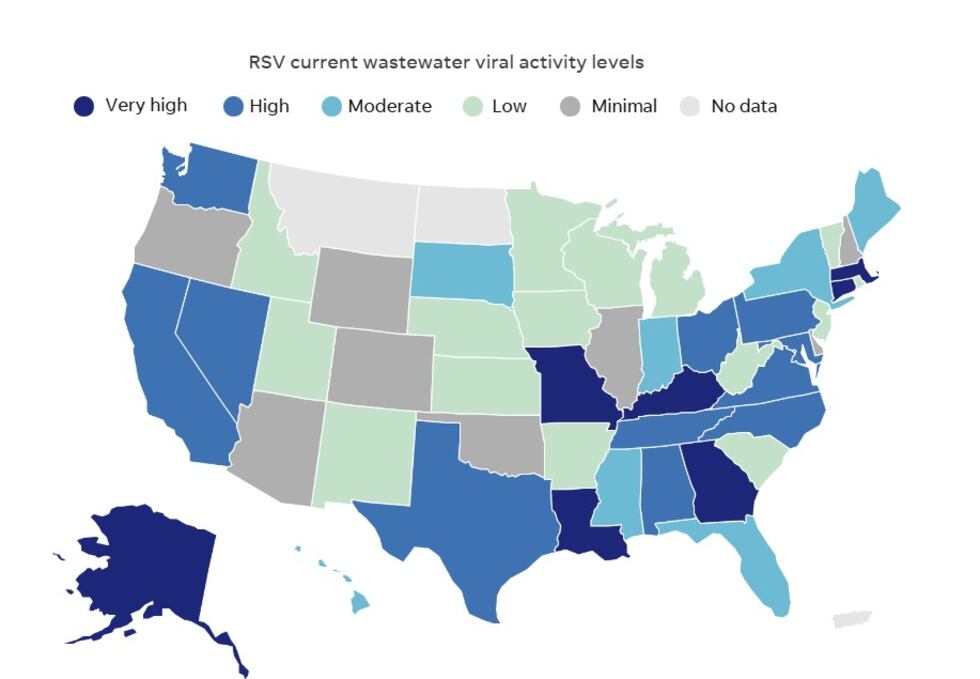Georgia, South Carolina grapple with high flu, RSV levels
Here’s what to know about those ‘bugs’ going around, including the virus that causes COVID, the flu, norovirus and RSV.
AUGUSTA, Ga. (WRDW/WAGT) - The Centers for Disease Control and Prevention reported high rates of influenza in Georgia and South Carolina.
A quadruple whammy of viruses – flu, COVID, norovirus, and respiratory syncytial virus, or RSV – is hitting the U.S. as the year comes to a close.

The Centers for Disease Control and Prevention has already signaled that influenza A, COVID and norovirus (stomach flu) are on the rise across the U.S. Now, the risks of getting RSV – a virus that causes cold-like symptoms, affecting the breathing ages and lungs – is escalating, too.
Wastewater levels of RSV rose to “moderate” nationwide for the week ending Dec. 21, according to the CDC’s wastewater monitoring system. That’s the first time it has risen to that level since January 2024. Since then, RSV levels in wastewater had been “minimal” or “low,” according to the CDC.
HEALTH HELP
Symptoms: Is it a cold, the flu or COVID?
- COVID symptoms may include fever or chills, cough, body aches, headaches, tiredness, shortness of breath and loss of taste or smell.
- Centers for Disease Control and Prevention experts say a sore throat, sneezing, itchy or watery eyes, and a running or stuffy nose are less common with COVID-19.
- Someone with the flu may experience all these ailments, but the loss of taste or smell is more frequent with COVID-19.
- When it comes to colds, fever or chills are not common, but you may have a cough, body aches, tiredness, be sneezing or have a runny or stuffy nose.
- In winter months, even allergies can act up, but generally that will not cause fever or chills, body aches or a loss of taste or smell.
The CDC monitors viruses in wastewater because it can provide insight into the prevalence of illnesses in the population. The last time RSV levels in the water were rated as “high,” was during the weeks ending Dec. 30, 2023 and Jan. 6, 2024, according to the CDC.
An estimated 22,000 to 45,000 people were hospitalized with RSV from Oct. 1-Dec. 7, the CDC says. That’s more hospitalizations than for the flu (15,000–33,000), but fewer than for COVID-19 (72,000–120,000), the CDC says.
“We expect to see an uptick in many of these conditions during the winter,” Noah Greenspan, program director of the Pulmonary Wellness & Rehabilitation Center in New York City, told USA TODAY recently. However, he added, “this also indicates that people may not be as careful as they need to be to keep themselves safe.”
Georgia seniors will no longer pay more than $2,000 for prescriptions
Thanks to U.S. Senator Jon Ossoff, Georgia seniors will no longer have to pay more than $2,000 per year for prescription drugs.

Cold season tips: How to avoid catching COVID and flu during the holidays
COVID, flu and norovirus on the rise, CDC says
The level of the virus that causes COVID-19 is up in wastewater, too, according to the CDC’s National Wastewater Surveillance System. That viral activity level is currently “high” nationwide, for the week ending Dec. 21, up from “moderate” last week and “low” the week before.
Nationally, the amount of influenza A virus in the nation’s wastewater has risen, too, but remains in the moderate range, for the week ending Dec. 21, according to the CDC. “Seasonal influenza activity continues to increase across the country,” the CDC said.
The agency has also reported an increase in outbreaks of norovirus (stomach flu) – 91 outbreaks during the week of Dec. 5, up from 69 the previous week.
How to tackle New Year’s resolutions made for your mental health
Many of us make resolutions heading into the new year to better ourselves, but we also find those resolutions are often abandoned after a few short weeks.

Where is risk of RSV highest in the US?
Across the U.S., 18 states and the District of Columbia have “high” or “very high” levels of RSV in their wastewater, according to the CDC’s monitoring system. Seven states have “moderate” RSV levels; 13 states have “low;” and 11 states have “minimal.” Montana and North Dakota had no data, the CDC said.
Here are the states with the highest RSV levels in wastewater, according to the CDC:
- Very high: Alaska, Connecticut, Georgia, Kentucky, Louisiana, Massachusetts and Missouri (Missouri’s level is based on less than 5% of the population, the CDC says).
- High: Alabama, California, District of Columbia, Maryland, Nevada, North Carolina, Ohio, Texas, Tennessee. Levels for Pennsylvania, Virginia and Washington are based on less than 5% of the population.

What is RSV?
Respiratory syncytial virus (RSV) causes infections of the breathing ages and lungs. It’s so common that most children have been infected with the virus by age 2, according to the Mayo Clinic.
Anyone from infants to the elderly can catch RSV – there are RSV vaccines for older Americans and those who are pregnant to help protect newborns.
While most cases of RSV are mild, some can develop severe infections especially premature babies, infants, older adults, and those with heart and lung disease, or a weak immune system.
If RSV infection spreads, it can cause pneumonia or bronchiolitis (inflammation of the small airway ages entering the lungs), the Mayo Clinic says.
Two years ago, RSV overwhelmed children’s hospitals. Each year, RSV leads to 58,000–80,000 hospitalizations among children younger than 5 years old and 100,000–150,000 hospitalizations among adults 60 years and older, according to the CDC,
RSV also s for about 2.1 million U.S. outpatient visits among children younger than 5 years old.
What are the symptoms of RSV?
In most cases, RSV symptoms resemble that of the common cold. Here’s what symptoms you may develop, according to the Cleveland Clinic:
- Sore throat
- Congestion
- Cough
- Fever
- Lack of energy
- Mild headache
- Runny nose
But more severe RSV infections can lead to one or more of these symptoms, the Cleveland Clinic says:
- Extreme tiredness or weakness
- Low appetite
- Persistent cough
- Wheezing
- Shortness of breath
- Bluish skin, lips or nails
- Sudden change in mental state
Infants can get severe cases of RSV, the Mayo Clinic advises. Additional signs and symptoms of severe RSV infection in infants include:
- Short, shallow and rapid breathing
- Struggling to breathe − chest muscles and skin pull inward with each breath
- Poor feeding
- Irritability
Think you have RSV? Here’s what to do
Mild cases of RSV usually go away within one to two weeks, the CDC says. While ill, the Cleveland Clinic recommends you treat yourself as if you had a cold:
- Drink plenty of fluids.
- Get rest.
- Use a cool mist vaporizer.
- Take over-the-counter (OTC) medications and home remedies to manage a fever and pain with acetaminophen (Tylenol) and ibuprofen (Advil). Note: Talk to your provider before taking any cold medications. Some may interact with other medications you’re taking.
- Continue taking prescription medications for asthma, COPD or other conditions as your provider recommends.
Severe cases of RSV may require hospital care. For instance, if you are having difficulty breathing or experiencing worsening symptoms, seek emergency care, the CDC suggests.
Especially seek immediate medical attention if your child – or anyone who’s ill with RSV – has difficulty breathing, a high fever, or a blue color to the skin, particularly on the lips and in the nail beds, the Mayo Clinic recommends.
RSV can be deadly. This fall, the CDC estimates 980 to 2,300 people have died from RSV during the period from Oct. 1-Dec. 7.
Copyright 2025 WRDW/WAGT. All rights reserved.















